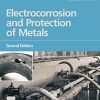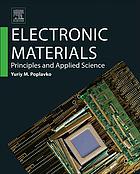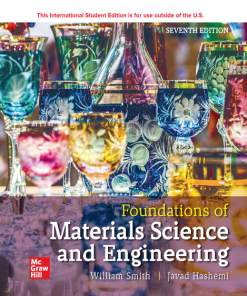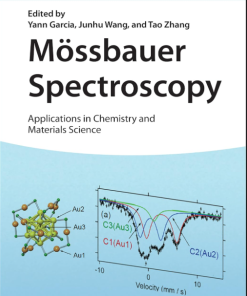(Ebook PDF) Materials Science in Photocatalysis 1st Edition by Elisa Garcia Lopez, Leonardo Palmisano 0128218606 9780128218600 full chapters
$50.00 Original price was: $50.00.$25.00Current price is: $25.00.
Materials Science in Photocatalysis 1st Edition by Elisa I. Garcia Lopez, Leonardo Palmisano – Ebook PDF Instant Download/DeliveryISBN: 0128218606, 9780128218600
Full dowload Materials Science in Photocatalysis 1st Edition after payment.
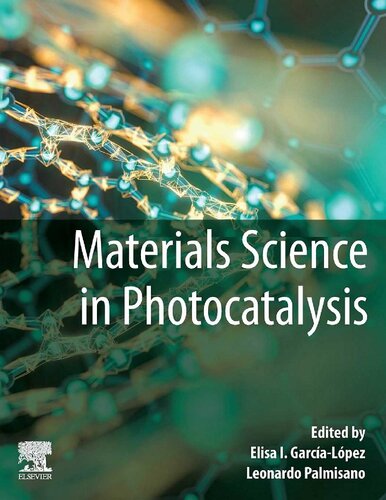
Product details:
ISBN-10 : 0128218606
ISBN-13 : 9780128218600
Author: Elisa I. Garcia Lopez, Leonardo Palmisano
Materials Science in Photocatalysis provides a complete overview of the different semiconductor materials, from titania to third-generation photocatalysts, examining the increasing complexity and novelty of the materials science in photocatalytic materials. The book describes the most recommended synthesis procedure for each of them and the suitable characterization techniques for determining the optical, structural, morphological, and physical-chemical properties. The most suitable applications of the photocatalysts are described in detail, as well as their environmental applications for wastewater treatment, gaseous effluents depollution, water splitting, CO2 ?xation, selective organic synthesis, coupling reactions, and other selective transformations under both UV light and visible-light irradiation.
Materials Science in Photocatalysis 1st Table of contents:
Chapter 1: Fundamentals of photocatalysis: The role of the photocatalysts in heterogeneous photo-assisted reactions
Abstract
1: Introduction
2: Basic principles of photocatalysis
3: Conclusions
Section B: Fundamentals of preparation and characterization of photocatalytic materials
Chapter 2: Preparation of photocatalysts by chemical methodologies
Abstract
1: Introduction
2: Synthesis of photocatalysts as powders by chemical methodologies: An overview
3: Conclusions
Chapter 3: Preparation of photocatalysts by physical methodologies
Abstract
1: Introduction
2: Bulk photocatalysts
3: Preparation of supported photocatalysts as thin films and coatings
4: Conclusions
Chapter 4: Flame-based synthesis of oxide nanoparticles for photocatalytic applications
Abstract
1: Flame-based synthesis of oxide nanoparticles
2: Application of flame-based synthesis to photocatalysis
3: Flame-based synthesis of materials with potential photocatalytic applications
4: Conclusions
Chapter 5: Methodologies of synthesis of titania and titania-graphene photocatalysts
Abstract
1: Introduction to synthesis methodologies
2: Gas phase methodologies for TiO2 production
3: Liquid phase methodologies for TiO2 synthesis
4: Solid-phase production for TiO2 synthesis
5: Removal of solvents: Washing step
6: Heat treatment step
Chapter 6: Experimental methods in thermodynamic and kinetic studies on photocatalytic materials
Abstract
Acknowledgment
1: Introduction
2: Band gap energy determination
3: Band edges and Fermi level
4: Density of states and intraband gap states
5: Kinetics of photoinduced electron transfer
6: Conclusions
Chapter 7: Photoelectrochemical characterization of photocatalysts
Abstract
1: Introduction
2: Fundamentals on photocurrent spectroscopy
3: Photoelectrochemical behavior of semiconductor/electrolyte junction
4: Energetics of semiconductor/electrolyte junction
5: Conclusions
Chapter 8: Application of EPR techniques in the study of photocatalytic systems
Abstract
Acknowledgments
1: Electron paramagnetic resonance: Short introduction
2: EPR studies of nanocrystalline photocatalysts
3: EPR studies of dispersed photocatalytic systems
Chapter 9: Approaching photocatalysts characterization under real conditions: In situ and operando studies
Abstract
1: Introduction. Promises and challenges of in situ and operando studies in Photocatalysis
2: Operando FTIR for the study of photocatalytic processes
3: Raman and other vibrational spectroscopies
4: X-ray absorption spectroscopy
5: XPS
6: Magnetic resonance techniques: NMR and ESR
7: Concluding remarks
Section C: Oxides and calcogenides
Chapter 10: Titanium(IV) oxide
Abstract
1: Titanium(IV) oxide
2: Photocatalytic activities of anatase and rutile
3: Amorphous titania
4: Brookite titania and TiO2(B) [36]Chapter 11: Development of hight active visible light-responsive TiO2 photocatalysts by applying ion engineering techniques
Abstract
1: Introduction
2: Ion engineering techniques
3: Visible light responsive TiO2 photocatalysts
4: Conclusions
Chapter 12: Semiconductor @ sensitizer composites for enhanced photoinduced processes
Abstract
1: Introduction
2: Semiconductors in photocatalysis
3: Porphyrin and phthalocyanine sensitizers
4: Advanced composite (hybrid) photocatalysts
Chapter 13: Nanostructured-based WO3 photocatalysts: Recent development, activity enhancement, perspectives and applications for wastewater treatment
Abstract
1: Introduction
2: Recent developments
3: Nanostructures of WO3
4: Heterostructures of WO3
5: Photocatalytic activity enhancement of WO3
6: Conclusive remarks and perspectives
Chapter 14: Photoactive systems based on semiconducting metal oxides
Abstract
Acknowledgments
1: Introduction
2: Photocatalytic phenomena explained via electron paramagnetic resonance technique
3: Conclusions
Chapter 15: Iron oxide-based magnetic photocatalysts: Recent developments, challenges, and environmental applications
Abstract
1: Introduction
2: Iron oxide-metal oxide photocatalysts
3: Iron oxide-carbon containing photocatalysts
4: Iron oxide-polymer photocatalysts
5: Conclusion
Chapter 16: Strategic design and evaluation of metal oxides for photocatalytic CO2 reduction
Abstract
1: Introduction: Greenhouse gases and climate change
2: Photocatalysis and photocatalytic CO2 reduction
3: Strategic design and evaluation of metal oxides in photocatalytic CO2 reduction
4: Conclusions
Chapter 17: Nanostructured sulfide based photocatalysts using visible light for environmental and energy purposes
Abstract
1: Introduction
2: Tri- and tetrahedrally coordinated sulfides
3: Sulfides having sixfold coordinated cations
4: In2S3
5: A system related to In2S3: ZnIn2S4
6: SnS2
7: Conclusions
Chapter 18: Synthesis of MoS2 materials for photocatalysis applications and pollution abatement
Abstract
1: Introduction
2: Structures and properties of molybdenum disulfide (MoS2)
3: Preparation of MoS2
4: Modification of MoS2
5: Application of MoS2
6: Summary and perspective
Chapter 19: Heterogeneous photocatalysts based on iso- and heteropolytungstates
Abstract
Acknowledgments
1: Photocatalysis by polyoxotungstates
2: POTs heterogenized on photocatalytically inert supports
3: POTs heterogenized on photocatalytically active supports
4: Conclusions
Chapter 20: Heterogeneous photo-assisted catalytic hydration/dehydration reactions based on Keggin and Wells–Dawson type heteropolytungstates
Abstract
1: Introduction
2: HPAs based on heterogeneous photocatalysts
Section D: Composites and heterojunctions. Tertiary materials
Chapter 21: Niobate-based perovskites: Characterization, preparation, and photocatalytic properties
Abstract
1: Aims and scope
2: Introduction
3: Niobates perovskites
4: Perspectives
Chapter 22: Insights on the photocatalytic performances of LaFeO3 synthesized by solution combustion synthesis
Abstract
1: Introduction
2: Synthetic strategy
3: Physical–chemical characterization of LaFeO3
4: Photocatalytic applications and performances of LaFeO3
5: Peculiar behavior related to pretreatment issues
Chapter 23: TiO2-copper zinc tin sulfide (CZTS) photocatalytic thin films for up-scalable wastewater treatment
Abstract
Acknowledgments
1: Introduction
2: TiO2-CZTS thin film deposition
3: TiO2-CZTS thin film characterization and testing
4: The photocatalytic removal of pollutants
5: Conclusions
Chapter 24: Graphene and graphene-oxide for enhancing the photocatalytic properties of materials
Abstract
1: Short general introduction
2: Graphene and GO, preparation, composition, structure, behaviors
3: Applications in photocatalysis
4: GO and rGO in hybrid materials for water depollution and disinfection
Chapter 25: Nanostructured composites based on Bi and Ti mixed oxides for visible-light assisted heterogeneous photocatalysis
Abstract
Acknowledgments
1: Introduction
2: Influence of Bi2O3 loading on the properties of TiO2 + β-Bi2O3 composites
3: Influence of TiO2 support on the properties of TiO2 + β-Bi2O3 composites
4: Concluding remarks and research perspectives
Chapter 26: Composite materials in thermo-photo catalysis
Abstract
Acknowledgments
1: Thermo-photocatalysis: A brief outlook
2: Environmental applications in thermo-photocatalysis
3: Energy-related applications of thermo-photocatalysis
4: Synthesis of chemicals with thermo-photocatalysis
5: Conclusions
Chapter 27: Plasmonic photocatalysis
Abstract
1: Introduction
2: Synthesis of plasmonic photocatalysts
3: Mechanism clarifications on plasmonic photocatalysts
4: Applications
5: New trends for activity and stability enhancements
6: Summary and conclusions
Section E: 2D Materials
Chapter 28: Graphitic carbon nitride-based metal-free photocatalyst
Abstract
1: Introduction
2: Organic semiconductors: A focus on g-C3N4
3: Synthesis and modification of g-C3N4
4: g-C3N4-based heterojunction photocatalysts
5: g-C3N4 as photocatalyst: Applications
6: g-C3N4 beyond (photo)catalysis: Analytical applications
7: Conclusions
Chapter 29: Two-dimensional layered double hydroxide based photocatalysts for environmental clean-up and renewable energy production
Abstract
1: Introduction
2: Characteristics of LDHs as photocatalysts
3: Applications of photocatalytic systems
4: Conclusion and perspective
Chapter 30: Crystalline two-dimensional organic porous polymers (covalent organic frameworks) for photocatalysis
Abstract
Acknowledgments
1: Introduction
2: COF based photocatalytic reactions
3: Conclusions
Chapter 31: Photocatalytic membranes and membrane reactors for CO2 valorization
Abstract
1: Introduction
2: Membrane reactors
3: Membrane Reactor configurations
4: Photocatalytic membrane solutions
5: Photocatalytic membrane reactors for CO2 reduction
6: Photocatalytic CO2 reduction in continuous membrane reactors: Case studies
7: Photoelectrocatalytic membrane reactor
8: Perspectives and challenges
Section F: New frontiers in nanomaterials for photocatalysis
Chapter 32: Photocatalysis by metal-organic frameworks
Abstract
Acknowledgments
1: Introduction
2: MOFs as photocatalysts
3: General photocatalytic mechanism
4: Photocatalytic hydrogen generation
5: Photocatalytic CO2 reduction
6: Benzyl alcohol oxidations
7: Pollutant degradation
8: Photoredox reactions
9: Conclusions and future perspective
Chapter 33: Ti-based metal–organic frameworks for visible light photocatalysis
Abstract
Acknowledgments
1: Introduction
2: Visible light photocatalysis of Ti-MOFs for selective organic transformations
3: Concluding remarks
Chapter 34: Homogeneous photocatalysts immobilized on polymeric supports: Environmental and chemical synthesis applications
Abstract
Acknowledgment
1: Introduction
2: Homogeneous photocatalysts
3: Immobilization of homogeneous photocatalyst
4: Summary and future prospects
Chapter 35: Soluble bioorganic substances from compost as photosensitizers for a sustainable homogeneous and heterogeneous photocatalysis
Abstract
1: Introduction
2: Types of SBOs: From the original biowaste to extraction methods
3: Composition and general features of SBOs
4: Applications of SBOs
5: SBOs in homogeneous and heterogeneous catalysis
6: Characterization of SBO-containing photocatalytic materials
7: Performance of SBO-containing materials in photocatalysis
Chapter 36: Biology-inspired photocatalysis: Recent advances in biomimetic photocatalytic nanosystems synthesis and applications
Abstract
1: Overview of bioinspired photocatalysis
2: Biomaterial-assisted photocatalysts synthesis
3: Biostructure-inspired photocatalysts
4: Biohybrids in photocatalysis
5: Concluding remarks and outlook
Chapter 37: Fungal resistance on photocatalytic ceramic surfaces: The ultimate role of the metal in the Ag@TiO2 photocatalyst under dark and light conditions
Abstract
1: Introduction
2: Experimental
3: Results and discussion
4: Conclusions
People also search for Materials Science in Photocatalysis 1st:
examples of photocatalysis
materials in photosynthesis
materials used in photosynthesis
photocatalysis materials
a material scientist studies
You may also like…
Housekeeping & Leisure - Games: Chess
Medicine - Clinical Medicine
Epigenetics in Precision Medicine 1st Edition by Jose Luis Garcia Gimenez B09LSZY6MG
Engineering - Mechanical Engineering & Dynamics
Foundations of Materials Science and Engineering 7th Edition William Fortune Smith
Engineering - Industrial Engineering & Materials Science
Nanostructured Materials for Visible Light Photocatalysis (Micro and Nano Technologies) 1st Edition
Mathematics - Operator Theory
Engineering - Industrial Engineering & Materials Science
Politics & Philosophy - General & Miscellaneous Philosophy
Metaphysics and Cognitive Science Illustrated Edition Alvin I Goldman



